You may have heard the advice, over and over again, to allow your pasture grasses to reach 6-8 inches in height before you let your horses graze. And then you’re also advised to pull them off when those grasses are 3-4 inches high.
You may be wondering, WHO does that?? As I drive around the horse properties in my area, I can tell you: Not too many! This is more the typical grazing pattern you see around here in this rainy climate where land has shot up in the last five years to $1 million per acre:
So I have never understood how the rotational grazing advice actually works, or is even possible, unless you have 20 acres or more… UNTIL I watched this video! And then the giant A-ha clicked into place.
Like me, you may have been wondering: Okay, so I can let the grass grow to 6 inches at the start of the grazing season (when the ground is dry enough that the hooves don’t destroy the root system), but if I pull them off after they’ve grazed only 2 inches worth… and put them on another patch… then the first patch is NOT going to have time to re-grow to 6-8 inches before I need to put them back on there… so??
But as this video shows us, the KEY element is that grasses with a 6 inch root length (what you see above ground is also below ground) and 4 inches of stem (aka flowering leaf) can re-grow 3-4 inches in only five days!
According to Krista Lea from the UK’s Department of Plant and Soil Sciences:
“Grasses absorb sunlight in their leaves and produce energy from photosynthesis. This energy is then used for growth or stored in the roots as carbohydrates. When grass is grazed (or mowed), leaves are removed, reducing the amount of light the plant can absorb and energy it can produce. To recover, grasses use carbohydrates from the roots to regrow their leaves. But this comes at a price: Roots will physically shrink as these carbohydrate reserves are used up. Once the leaves are able to absorb adequate sunlight for photosynthesis, the root reserves are replenished. This is a normal process and allows grasses to recover from grazing and thrive.”
So the reason the grass can grow so fast when it’s longer (4-6 inches) is because the longer the grass, the more energy it can pull (via photosynthesis) to fuel rapid growth. Et voila!
The reason long grasses contain less sugar is because the plant is not stressed, and so is not pulling carbohydrates (sugar) from the roots, to fuel it’s growth. The other aspect that creates higher sugar levels in grass is drought. Again, lack of water stresses the plant and thus increases the carbohydrate/sugar requirement. So if sugar is a big concern, then make sure you can irrigate your pastures in case of drought. And of course, don’t let your grass height fall below 4 inches. As Krista Lea says:
“The bottom line is that healthy pastures need healthy roots. Think of the soil surface as a mirror: whatever you see above the ground is also what’s below. Pastures with tall, thick grasses will also have thick, healthy roots. These will hold the soil down during heavy rainfall, withstand hoof and tractor traffic better, and survive longer in droughts. Conversely, thin, short, overgrazed pastures will have shallow, sparse roots and will be more vulnerable to traffic, drought, and grazing.”
The key here is to ideally have 3 pastures for rotational grazing. Or you can put them in your ‘sacrifice field’ or dry lot area and hay feed for a couple days in between if you need to.
Seeding a trashed field
Here’s another piece of advice you’ve probably heard over and over if you live in a rainy climate: Confine your horses to a dry area, or small sacrifice field over the wet months, or they will destroy the root system and your pastures will have no grass left in the Spring/Summer.
And when they say “destroy”, they’re not kidding:
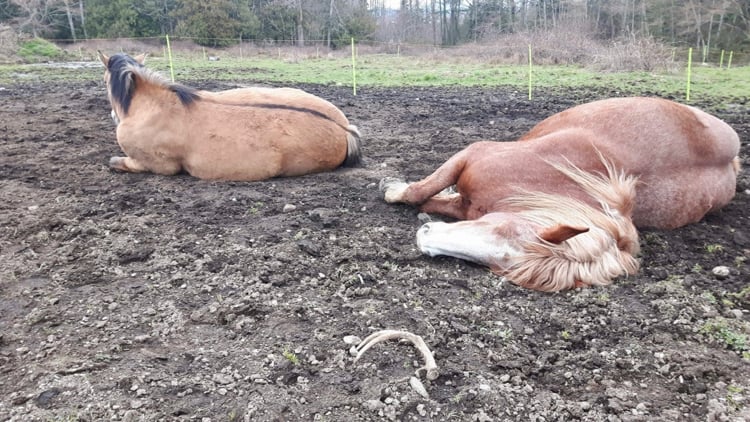
Again, I understand the logic behind this advice. BUT. Following that advice also means my horses will have nowhere to run, play, wrestle for 7 months of the year! And I personally LOVE to see them thundering over the fields – it’s one of my favorite things.
So… I let them trash their main pasture. It wasn’t too bad the first year, but the second year (see pic above) it was pure mud in the winter and was going to be a dust bowl in the summer. So we electric-fenced off most of it, leaving them a walking track around the outside perimeter.
I had no idea about soil pH, fertilization materials or rate, or even which forage grasses would grow well in this climate, and on this soil. After doing reams of research I was even more afraid and started looking for a consultant to hire.
Then something in me started to rebel against it all being so darn precious. C’mon, grasses have been seeding and sprouting themselves for millennia without the help of humans! How hard can it be??
The year before I had bought a 60 lb bag of ‘horse and sheep’ grass/forage mix from the feedstore and just scattered it over the pasture – without fencing it off – to see if that would work. Nope. Total waste of $180.
So this year, we spread a pasture forage mix inside the fenced-off area only – avoiding the places that were flooded with water (too much water and the seeds will rot) and feeling for the right time to sow… the time where rains had just finished and we would get some good sun to help the seeds sprout before the rains hit again. Total nail-biting crapshoot, right? Lord, I don’t know how farmers do it – worse than gambling in Vegas if you ask me.
Well amazingly, we hit it just right: We hand-spread the seed a day after the rains stopped, then we got 5 days of solid sun, it rained again for 2 days, then 2 more days of sun, et voila:
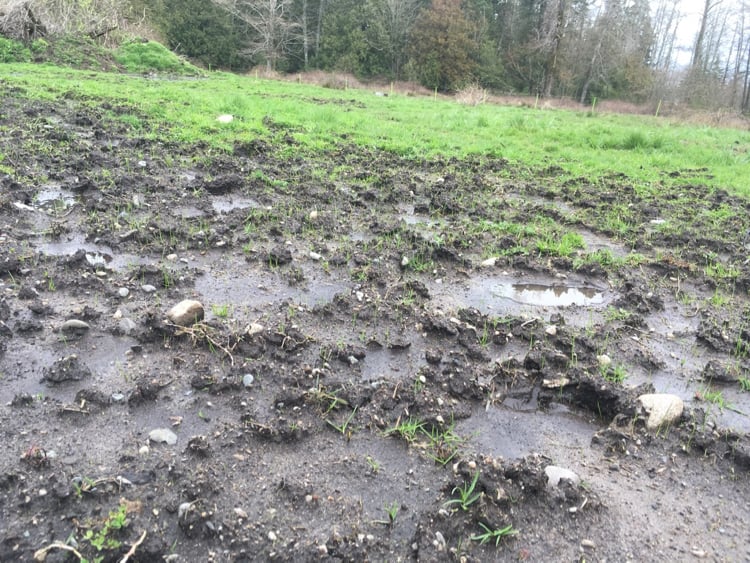
Note: This year I have a friend who studied Horticulture in college and he told me to seed in mid-April when the overnight temperatures should get up to 7 degrees Celsius (or higher) as this will encourage fast germination. Great advice. The other thing I changed this year was to add 1/4-1/2 inch of composted horse manure with live worms first, then I sprinkled the forage seed. I followed Will Harris’ advice and seeded at 15 lbs per acre. If you want to be really rigorous, walk all over the seeds after sprinkling to press them down into the soil. This worked brilliantly!
Every week or so, we checked to see how things were growing…

By the time the grass hit this height, the horses would stand at the electric fence, waiting… begging to be let in:
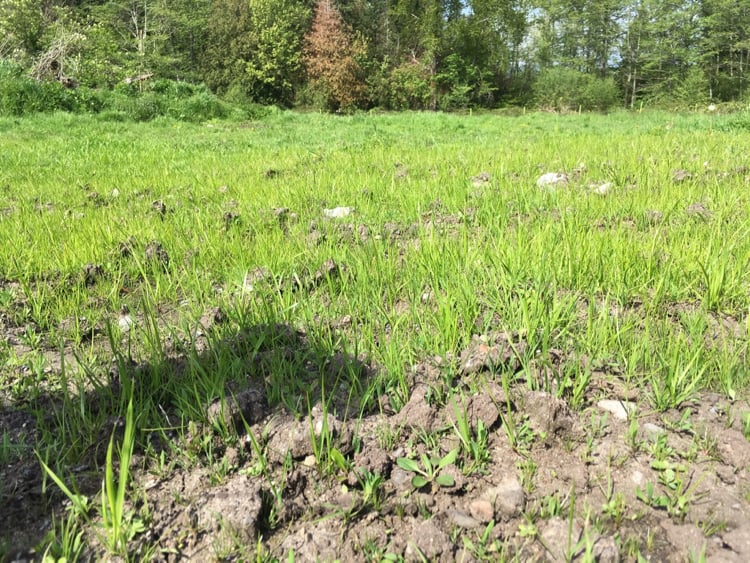
And now that I finally understand how quickly grass can regenerate if left longer than 4 inches, I definitely will not let the horses on here until this new pasture hits 6-7 inches high. Unless of course they get fed up with waiting and mow down the electric fence – which is always a possibility with my crew. Fingers crossed!
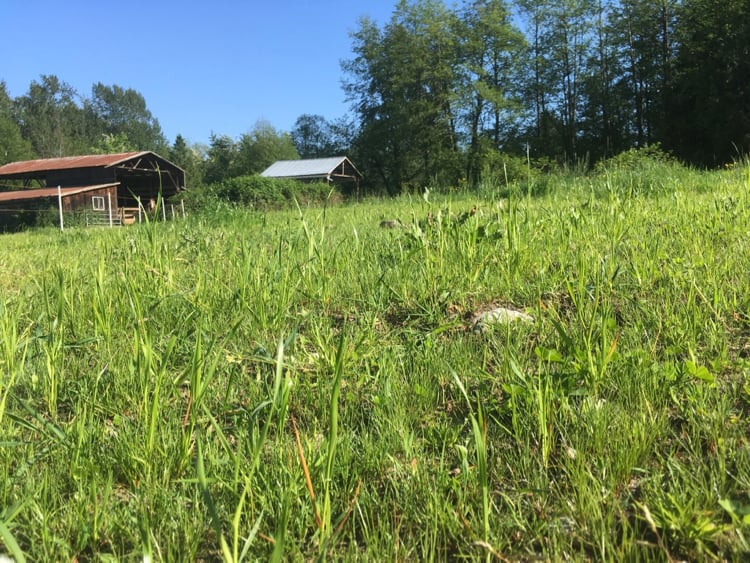
Luckily I had also been able to fence a new pasture for them at the back – which is in great shape. So as soon as the ground hardened (by which time the forage back there was tall enough) I opened up the gate to the back pasture as well. But thankfully, they did not get destructive with the electric fence in this field and the grass looked like this when I finally let them in for the first time – note the contrast with the plain dirt which was not seeded!
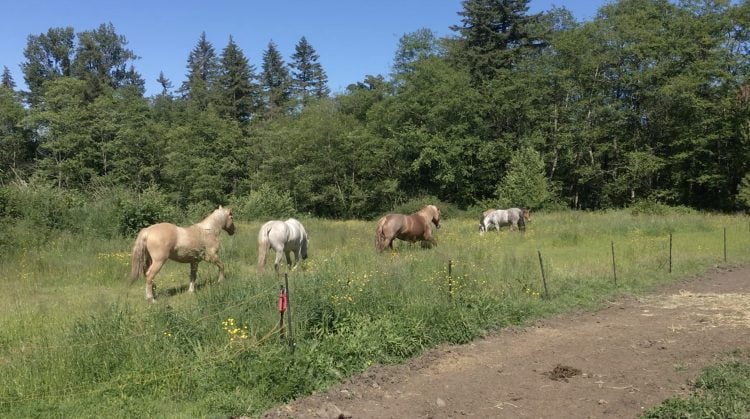
In some areas of the field, the grass is extra high and lush:
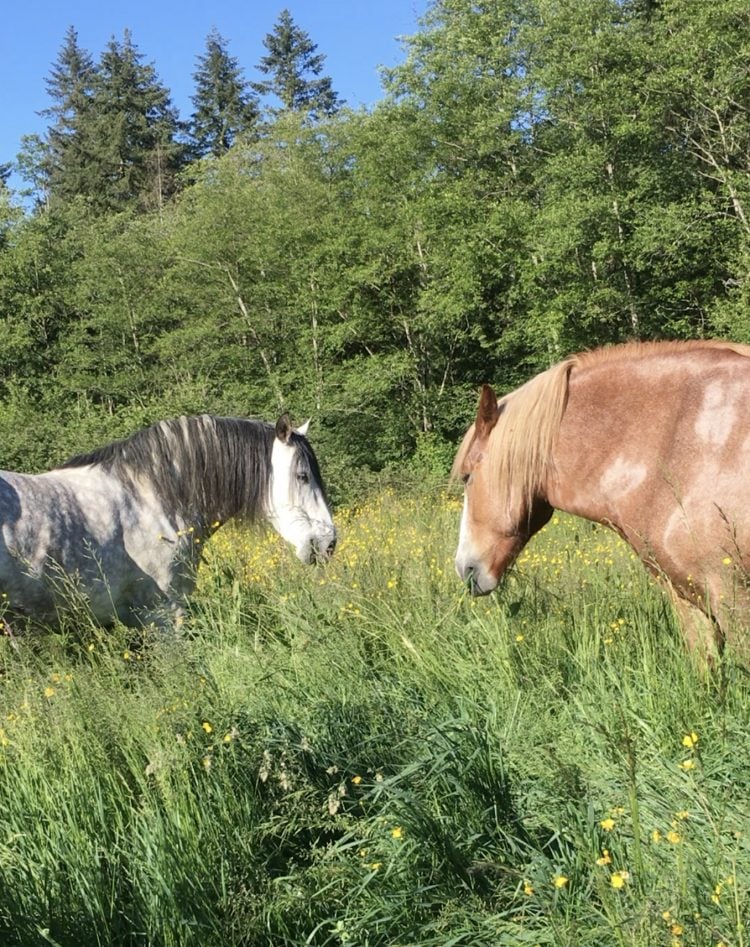

WELL WORTH the extra effort, wouldn’t you say? And so much nicer to see horses galloping across a field of green, rather than a dirt dust bowl.

Jini Patel Thompson is a natural health writer and Lazer Tapping instructor. She began riding at age 2 in Kenya, and got her first horse at age 8 in Alberta, and so continues a life-long journey and love affair with these amazing creatures.









Wow- thanks for that post! Super valuable info – I don’t have horses on my property but his will come in handy for all my other ruminants!
What animals do you have Christina? Do you have any sheep? Because we’re wondering if sheep will stay contained with a board fence, or if they need mesh fencing…?
Jini, I have sheep, goats, cattle, pigs and so on 🤣
Hmmmm, we have a woven wire perimeter fence. I would say it depends on the sheep breed. I have Icelandics and let me tell you, some of them are wild buggers! They would TOTALLY jump over fences, when needed!
I also have a few Jacob sheep, who are way more mellow. I would think, though, that most sheep should be ok in board fence with a few strands of hotwire.
I might also look for a mellow sheep breed.
Hope that helps!
That is so good to know! I would not have known there could be such variation. You got me going on a bit of a run here, like, check this out:
https://www.homesteadingtoday.com/threads/which-is-the-most-most-docile-sheep.294641/
Mice and voles destroy the pasture when we let grass grow higher. What can we do?
Hi Pat – I’m having a hard time imagining/understanding how mice can destroy a pasture… we had tons of field mice in Alberta and they co-existed just fine with the horses. Perhaps it depends on where you live. Likewise voles etc were never a problem in Alberta or BC, but in California – oy vey, I’ve seen pastures that look like Swiss cheese. In those regions, an Owl habitat (box) is your best bet. There are even companies that supply them and will come install the owl houses in the best location(s) for your pasture. Then the owls take care of the rodents. Best solution I’ve ever seen!
Looks amazing Jini! What a big win. This is grest to think about as we are building a small pasture/sacrifice zone in the hopes to let the big pasture get a head start. Once it does, they have enough room that nothing gets overgrazed, but as we consider more grazing residents here it feels good to be getting ahead of the curve and even better to see just how effective it is at your place. Our pigs get to roam at will in the afternoons and they have torn up some of the pasture…so my mom bought forage seed from a local farmer and we will just chuck some seed in what they have rototilled and see what happens! Having random patches of high-nutrient forage like oat and barley grasses will give the herds a chance to self-select and supplement…
My grass discovery this year was burning it when the snow melted…I know, sounds crazy, but it’s a time honoured tradition around here. So much so that someone burns something down in the valley just about every year 😆 talk about nail-biting gambles!
Since we have snow and serious cold through the winter, we end up with dead grass from the autumn before when the snow melts. We tried burning in our garden with serious perimeter control on a chilly day just before it got dry…and it was very satisfying. But indulging one’s pyromania aside, the grass greened up in the garden a week or more before it did in the sunburned pasture (since it didn’t have to push through the mat of old grass), and is now several inches higher than anything else too (bit of a backfire there as a garden is for growing food, not grass…have invited the goats in for supervised grazing…very dodgy). I think the burn, as well as the nutrients from the ash, stimulates rapid growth. No idea what the sugar content is though!
Doesn’t ash also have something to do with nitrogen levels… nitrogen-fixing?? I have some memory somewhere of that… And yes, in Alberta (similar winters) many burn their fields; not every year, but maybe every 2-3 years. And yes, they often (usually?) got out of control and neighbours were used to pouring out in droves to help while the fire trucks were on their way. But again, as per the Wilding book, what happens if we just let it be and let Nature be in control of the cycles? But also, in nature, there is never just one species grazing…
And so I’m pulled back to Will Harris’ wisdom (of White Oak Pastures) where he does rotational grazing using multiple species, for weed control, worm control and maximum fertilization of pastures. Maybe sheep are easier on fences than goats and don’t require a mesh fence to keep them contained?? What if all you need is a couple of cows and 3 or 4 sheep added to your horse herd/pastures and then all would be taken care of?
Yes, and don’t forget the chickens afterwards to spread out all that manure! At least that it he plan for this year, to actually fence the chickens into the vacated grass pasture after the ruminants leave…
ohmygosh – YES!! The chickens of course! Or those ‘chicken tractors’ you can move around the pasture by hand look pretty nifty too. But yes, having a perimeter fence would certainly be easier – as long as you don’t have a lot of predators around, or you have a good guardian dog or two!
Chicken tractors – *insert me gagging here* – are just moveable cages in my eyes. Have tried variations and it felt like a prison camp! Chickens are not pasture animals either, and need cover as well as good range…. but YES to them spreading manure, they are super fab at that. And YES to a few more grazers/ruminants – I’m not sure we would even need to rotate if we had few enough of everybody; so if you’re not trying to manage the land for too many animals (which you usually need to do if you’re in real production), and instead trying to see which and how many animals are needed to keep land in balance……now we’re getting somewhere interesting (not that pasture management isn’t interesting, but for someone with far more bush than pasture I like the second option better)…
Yes, I agree – rotating animals seems like too much hard work for me! But just having the right MIX of animals for the land – like they did in the Wilding project – seems ideal to me. And yes, I agree about portable cages – people who use them talk about predators, so I guess it would depend on what your losses were…
We started with animals just loose on our ten acres. It worked really well for the first few years. Now, that they really cleared out the underbrush and grass is growing, I feel we need to manage them a bit more because cattle hooves+wet weather is not a good mix for the grass. We don’t do chicken tractors- just inspire the chickens to come through where the ruminants were but spreading some grain for a few days. They know where the bugs are, lol, not much coercion needed. And for us LGDs are essential!
Ah, so with your good LGDs (livestock guardian dogs – for any others reading) how many chickens do you lose per year to predators? And did you have to train the dogs, or was it just in their genes?
Jini, well, since we weren’t prefect in following how to train LGDs to chickens, we did lose a few. One can manage the dogs in such a way, though, as to lose zero chickens while they are in training and growing up. The dogs and roosters together make a pretty good alarm system – we rarely lose birds to owls now or hawks.
Oh nice. One of my dogs is half Aussie Shepherd and half Kootenay Mountain Dog (Kesia has his sister) – which is a blend of LGDs – so I was wondering how training would go. He’s only been exposed to chickens once or twice and chased them, but didn’t bite at them. He’s such a mellow guy I don’t think he’d be hard to train. Thanks for all the info Christina! It’s wonderful to learn from people who are already doing what I’m heading towards 🙂
Very interesting Jini..Thank you! =-) Deb
I was advised a few years ago to throw seed over the pasture and so I did. Waste of money as far as I can figure. We tried dividing the field off so half could rest while they used the other side. All worked well until my princess mare Spirit showed up and she just plowed right through the line and tore out the little posts and the boys followed. I just read about the 6-8 inches grass growth that you should wait for. The bottom half of my field is wet and the top half is cracking. I let them down for about a half hour today and they chose to eat in the wet area (of course) and punch holes in it as they grazed. I should have checked it first before letting them go. As far as getting them used to grass, they are out on a side field that grass is slowing growing in but otherwise not an ideal pasture. They eat their hay in the pen area and then go out and nibble on grass in the side field and they don’t seem to be having any problem. They have been doing this for about a week or so and when they first started there was much at all. Its just gradually growing and I am not concerned about whether the grass is rooted enough or not but am aware that because it is short it may have a high sugar content. Certainly best not to let them on grass in the mornings here. We are still experiencing frost and temperatures of zero to 10 Centigrade and then by noon is in the 20s C. I don’t have any other animals. Just the three horses and I likely won’t because I can’t do the fencing and now don’t have any help I can rely on for that type of work. I would like to have chickens but we have too many predators and probably couldn’t keep them safe at night because racoons, fishers, Ermines are all genius at breaking in even the best chicken coops.
I’m trying not to be in a hurry to let them into the large summer pasture but don’t want to ruin the pasture or cause laminitis by not taking my time with it. By June they should definitely be there every day and hopefully there won’t be a drought here again this year like two years ago. Last year it was really wet all Spring and no one was able to get hay off. I really believe that the worse part of caring for animals is worrying about the hay every year.
It is certainly true that the better the grass is doing before you let the horses on it, the better it recovers. I have three acres of pasture (I live in CT) and two horses, and I find that if I manage it carefully I don’t have to feed any hay at all between May and September-ish. And we started the pasture from scratch the year before we moved in. The first few years I rotated the pasture every day, using portable electric fence to make them a new section every day. Then I would kick the manure piles to spread them, and hit the remaining tall stuff and weeds with the string trimmer. It allowed the grass to have a good long rest between grazings. Now I give them access to ~1/3 acre at a time which lasts about a week. I still spread the manure and mow when they’re done. I also spread all of my stall pickings, and the manure I pick up in the paddock, on the pasture in the off season. The pasture is doing really well now, so I feel like the extra effort of rotation is worth it. Not only does it feed them all summer, but unless the fall is super rainy I can still do turnout with supplemental hay in the fall, and once it freezes in the winter I can let them out as well.
There are always bare spots, and areas that get dug up. I get a bag of pasture seed every spring, and on the first rotation through I sprinkle it by hand in the areas that need a little extra filling in, then the horses stomp it in while they graze, and they’ve moved to the next spot by the time it starts to grow. This targeted seeding has improved the grass thickness a lot. Also, when I feed hay out on the pasture in the fall/winter, I try to drop the flakes in the thin areas, because a surprising lot of seed falls out of it and takes root.
I love your targeted seeding strategy Laura – and the way it works seamlessly with your pasture rotation. I am wondering about your manure process though… how hot does it get in CT? It has to hit a certain temperature, and for long enough to kill the worm eggs etc in the manure. Otherwise your horses will ingest them and greatly increase their worm burden:
https://listentoyourhorse.com/worming-horses-naturally-is-it-possible/
Your winters will kill them though, no problem there! So Spring grazing is fine.